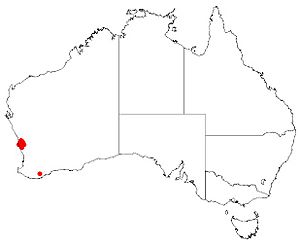Lesueur hakea facts for kids
Quick facts for kids Lesueur hakea |
|
|---|---|
| Conservation status | |
| Scientific classification | |
| Genus: |
Hakea
|
| Species: |
megalosperma
|
 |
|
| Occurrence data from AVH | |
The Lesueur hakea (scientific name: Hakea megalosperma) is a special type of shrub. It belongs to the Hakea plant family. This plant grows naturally in a small area along the west coast of Western Australia, in a region called the Wheatbelt. It's a small bush known for its sweet-smelling flowers. These flowers start white or pink and turn red as they get older. The plant also has thick, egg-shaped leaves that are a pretty bluish-green color.
What Does Lesueur Hakea Look Like?
The Lesueur hakea is a low, spreading bush. It usually grows about 1 to 2 meters (3 to 6 feet) tall and up to 2 meters (6 feet) wide. Unlike some plants, it does not have a special woody swelling at its base called a lignotuber.
Its leaves are bluish-green and shaped like an egg, or sometimes a narrow oval. They are about 3.7 to 8.2 centimeters (1.5 to 3.2 inches) long and 11 to 27 millimeters (0.4 to 1.1 inches) wide. Each leaf has a rounded tip with a tiny point, about 0.1 millimeters long. The leaves also have a clear vein down the middle and smooth edges. Sometimes, the tip of a leaf might even curl a little.
The flowers of the Lesueur hakea are strongly scented. They grow in groups and are usually white, cream, or pink. As they get older, they change color and become red. Each flower sits on a smooth stem about 2 to 3 millimeters long. The small stalks that hold individual flowers, called pedicels, are about 3.5 to 4.5 millimeters long. The flower parts, known as the perianth, are smooth and about 3 to 4 millimeters long. The female part of the flower, the pistil, is about 7 to 8.5 millimeters long.
After flowering, the plant produces large fruits. These fruits are shaped like an ellipse or an egg. They are quite big, about 7 to 8.5 centimeters (2.8 to 3.3 inches) long and 3.5 to 4 centimeters (1.4 to 1.6 inches) wide. The surface of the fruit has small, darker bumps that look like blisters. Each fruit ends with two pointed horns, about 8 to 10 millimeters long. The Lesueur hakea usually flowers in May and June.
How Did It Get Its Name?
The Lesueur hakea was first officially described in 1855. A scientist named Carl Meisner wrote about it in a scientific journal called Hooker's Journal of Botany and Kew Garden Miscellany.
The scientific name megalosperma comes from ancient Greek words. "Megalo" means "large," and "sperma" means "seed." So, the name megalosperma refers to the plant's large seeds.
Where Does Lesueur Hakea Grow?
The Lesueur hakea is a rare and endangered plant. This means there are not many of them left in the wild. It grows in a specific type of soil called lateritic sand plains. These are sandy areas with a lot of iron-rich rock.
You can find this plant in low heathland areas. Its natural home is in Western Australia, specifically from Jurien Bay to a place called Mount Lesueur.


